Russia Iron.
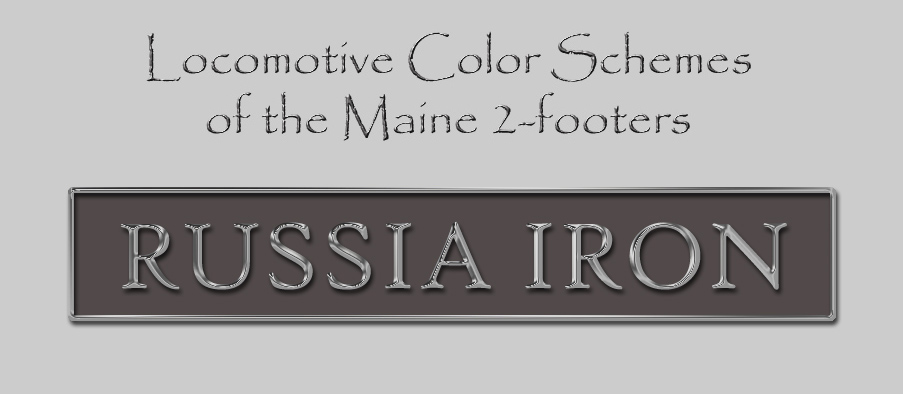
Locomotive Color Schemes of the Maine 2-footers.
Russia Iron.
| Page 2.
Russia Iron, also known as "Russian
Iron" was a special type of metal used on
locomotive boilers from approximately the 1870's
to the 1920's. The use of Russia Iron was fairly
widespread during those years, many Black &
White builder photos still exist that show what is
quite clearly a shiny Russia Iron boiler jacket.
but..the photos were all in Black & White,
because color photography wasn't in widespread use
until the 1940's and 50's. The original steam locomotives that had
Russia Iron boiler jackets ran out their careers
and faded out during the 1910's, 20's and 30's,
and by the 40's they were basically extinct. Then,
after WWII, the hobby of model railroading really
picked up in popularity. By the 1950's, 60's, and
70's people wanted to model those "old time" turn
of the (20th) century locomotives. But wait..what
color was Russia Iron exactly? No one knew! the
actual locomotives were gone, and all the photos
were in Black and White. For half a century,
roughly 1950 to the year 2000, the true color of
Russia Iron was temporarily lost to the model
railroading community! people "heard" is was
probably blue, perhaps from some old historic
accounts. Then, the model railroad manufacturers
made the whole thing *much* worse! by creating
models like this:
This was very very wrong, but no one knew it for quite some time. Some serious research on Russia Iron first appeared on the internet in 1997, when Jerry Kitts first posted some data he had received from Kyle Wyatt at the Nevada State Railroad Museum. Click here for that information, which contains reprints of actual 19th century articles on the topic. The Russia Iron was a boiler jacket. a protective metal cover to the boiler, wrapped around the outside of the boiler. It was not the main metal of the boiler itself. I don't intend this page to be a detailed treatise on what Russia Iron is, or was, or its history, or how it was made..since that data already exists in detail elsewhere, such as the link above, and links to other informational pages found at the bottom of this page. Instead I am making this page more as a guide to what Russia Iron looks like! and several methods for modeling it. because there is still some confusion even today about what real Russia Iron should look like. There are actually three different types of metal boiler jackets discussed here, and all are often lumped together under the term "Russia Iron" when used in a generic sense. First was the actual, genuine "Russia Iron"..made with the process first discovered in Russia, hence the name. But later on, locomotive builders began to use other processes, which may or may not be the same process for making the original version. the three processes are called: Russia Iron (or
Russian Iron, the terms are used interchangeably)
The exact difference between the three
processes is not fully known, and from a modeling
perspective the difference is unimportant, because
it all looks about the same, and can be
modeled in the same way. The later "American Iron"
or "Planished Iron" was used on new locomotives as
late as the 1920's. For the purposes of this
webpage, I will use the term
The main thing I want to get across, and
the thing that is no longer in dispute at all, is
that Russia Iron was NOT BLUE! It is generally believed that the "blue
myth" came about because any shiny, neutral,
reflective surface will reflect the colors around
it..so on a day with a bright blue sky overhead, a
russia iron boiler will reflect the sky, making it
appear to have bluish cast.. but it never was, and never has been blue. If conditions are right, the boiler
might look somewhat blue, reflecting a
blue sky.. but it will also look red if sitting
under an intense sunset, or orange if parked next
to a burning building! On an overcast grey day, the boiler will appear neutral grey..because it is. it has no inherent color shade of its own. Russia Iron was not painted, it was a specially treated Iron. The main advantage of this treatment was that it gave a protective finish to the boiler jacket, protecting the locomotive from damaging cinders, dirt and dust, and protecting from water and rust. As a side effect of this protective property, it also happened to be gorgeous! which railroads also used to great advantage. "The great blue myth" has been around
for 130 years or more. and modelers and model
train manufacturers are only now beginning to let
go of this myth. For most of the 20th century,
modelers and model train manufacturers represented
Russia Iron with...blue paint. Here are some examples of, in my opinion, very incorrectly done Russia Iron:
Light pastel "baby boy blue" is about as
far as you can get from real Russia Iron! And yes, in the above two examples, those are supposed to be representing Russia Iron, since those prototype locos did in fact wear Russia Iron, and it was the manufacturers intent to use that color to represent Russia Iron. Please note that some prototype locomotives did have painted boilers! (in colors such as blue or green, while nearly all 20th century locomotives had black painted boilers.) The Rio Grande K27 mudhen with a green boiler, Great Northern locos with green boilers, etc. are examples of that..these are unrelated to Russia Iron. To be fair, the model train manufacturers were simply doing what people expected Russia Iron to look like. everyone thought it was supposed to look like that! it was a very deeply entrenched myth! In the past 5 years or so, some model train manufacturers have started to get the message! there have been some new models appearing with MUCH more accurate representations of Russia Iron...and, doing it the right way looks SO much better! Im hoping the light pastel baby-blue will soon fade away completely. So..if that is what Russia Iron does not
look like, what does it look like then? In my opinion, the very best (looking) examples of Russia Iron in the world today exist on the two replica 4-4-0's at the Golden Spike National Historic Site in Utah. The two locomotives are full-size operating replicas of the locomotives that met at the historic "Golden Spike" ceremony on May 10, 1869, completing the American transcontinental railroad. When the replica locomotives were completed in 1979 and first painted, the National Park service had to make an "educated guess" on the color schemes of the two locomotives, because the actual historic schemes were not known at the time. They did a nice job, painting them both in an all-red scheme, but they didnt quite get it right! Later, railroad historians helped the Park service with the new schemes, making them much more historically accurate. The paint schemes today also includes the correct look for the historic Russia Iron boiler jackets on both locomotives. Here are some current photos of the two locomotives: |
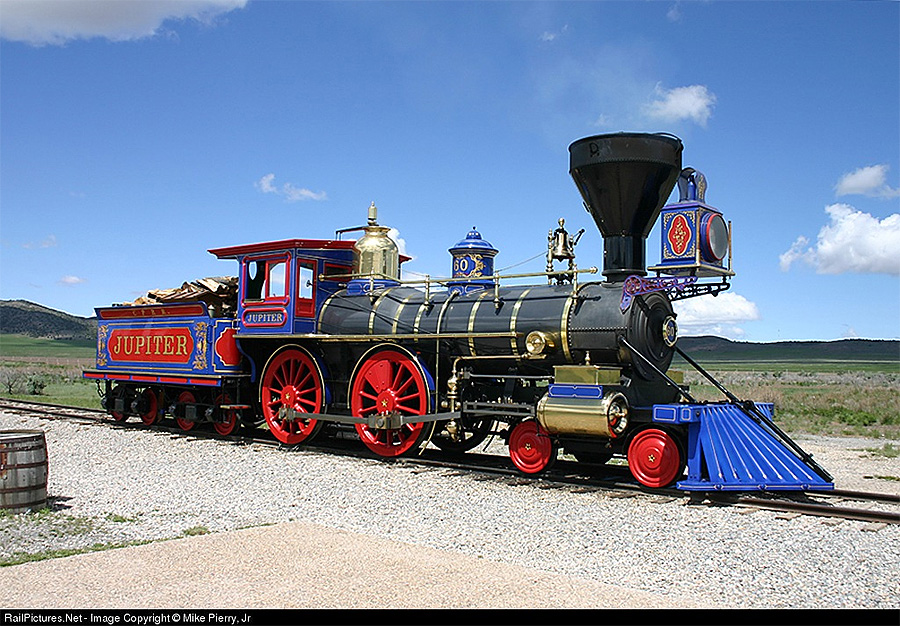
Photo
by Mike Pierry, Jr. used by permission.
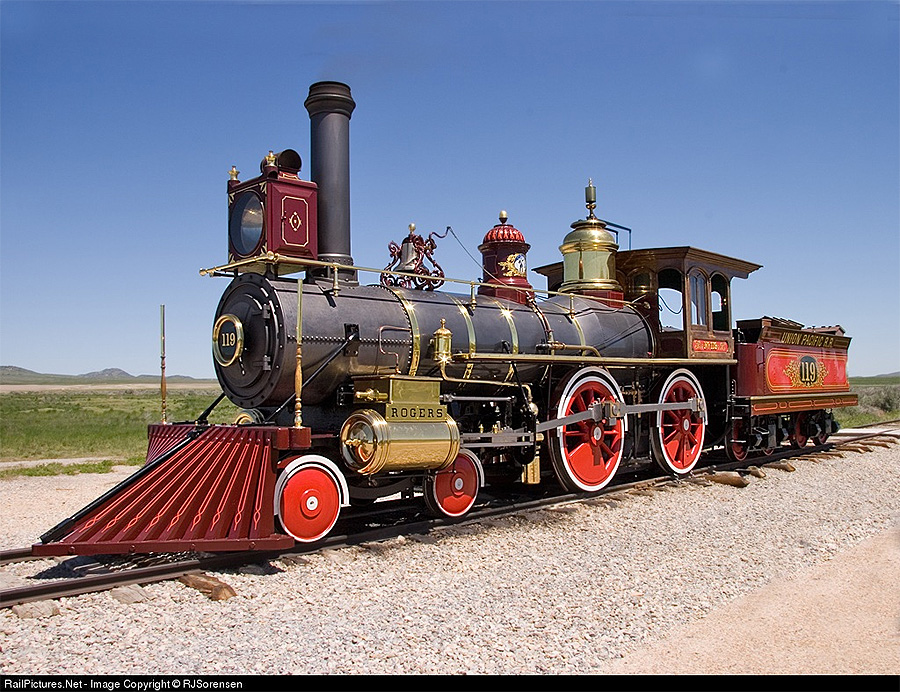
Photo
by RJ Sorenson, used by permission.
| For more photos of those locomotives,
click here.
One thing I am not aware of...how did they actually make those boiler jackets? Perhaps its just glossy grey paint? or an actual treated metal jacket? I dont know for sure. If anyone knows, please let me know! and I will share the information here. But, regardless of how it was made, THAT
look, for me, is the goal of what Russia Iron
should look like when making a model! Some more historic locomotives that have
accurate looking Russia Iron boilers include the "Sonoma"
at the California
State Railroad Museum,
And a few more good examples of "correct
looking" Russia Iron include some actual metal
jackets made by Chris DeWitt, master mechanic of
the Nevada State Railroad Museum, who developed a
chemical process for three locomotive boiler
jackets, V&T
22
INYO, A known actual example of
Russia Iron exists on a model, built in the
1880's, of a |
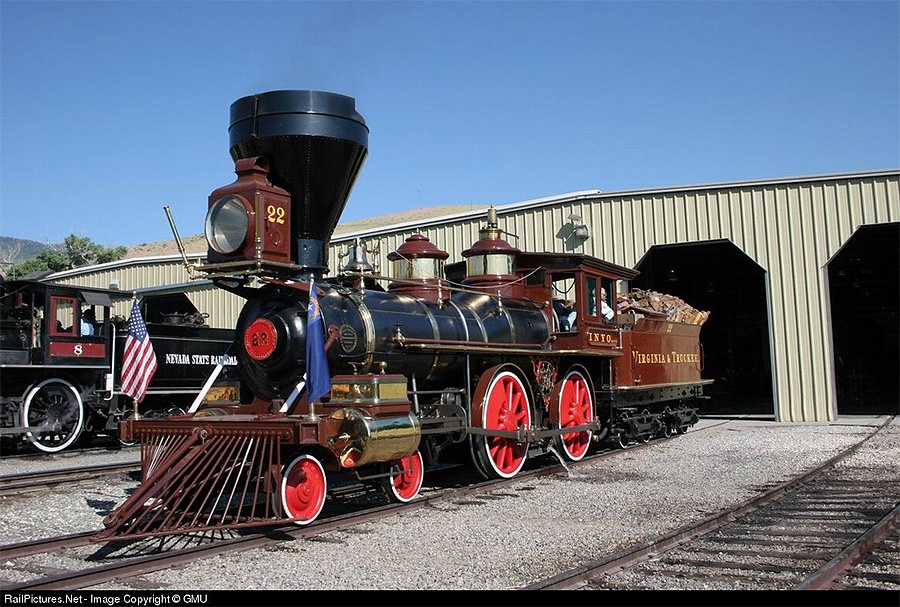
Photo
by "GMU", used by permission.
| That is the INYO at the Nevada State Railroad Museum, wearing a real metal jacket made by Chris DeWitt. |
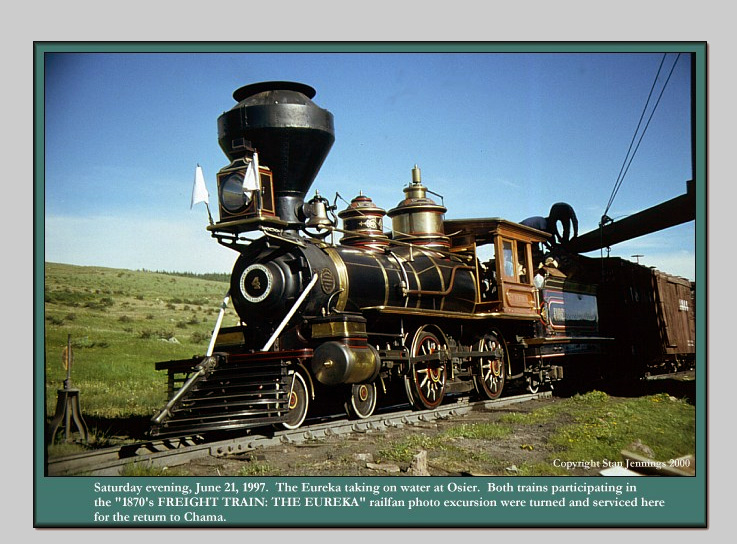
Photo
by
Stan
Jennings, used by permission.
| And above is Dan Markoff's "Eureka", a
restored and operating 3-foot gauge 4-4-0.
also wearing a real metal jacket by Chris DeWitt. Those two jackets are a bit darker in
grey tone than the Golden Spike locomotives.
All those locomotives look fabulous
however! and..as there were different processes used over a 50 year span, "Russia Iron", "American Iron" and "Planished Iron" were not exactly the same process, its extremely likely there was variation in tone on the actual prototype jackets..and coupled with differences in tone as jackets aged, its possible that both the lighter AND darker grey could both be quite historically accurate! depending on the age and history of the particular locomotive in question. Personally, I am going to use the Golden Spike locomotives as my quide when attempting to model Russia Iron. The important thing to notice, on all
four of the full-size locomotives shown above,
So..thats a look at full-scale Russia Iron..now, how about modeling it? Over in the Large Scale world, on mylargescale.com, there has been much interest and discussion about modeling Russia Iron over the last few years. Kevin Strong wrote an article about making a real metal jacket, using brass and "brass black" chemicals, that has been very well recieved and duplicated on many projects. Kevin's article can be found here. And here is one of Kevin's beautiful locomotives, with a brass jacket using that technique:
Nothing looks quite like real metal than
real metal! I tried my hand at the brass patina technique, resulting in a decent looking boiler:
Depending on the specific chemical used, you can end up with more of a "brownish" metal tone, which is what I have above. I don't consider it very accurate for "new" Russia Iron, because its too dark and too brown, it should be lighter and neutral grey, but it could represent a Russia Iron jacket that has been "on the road" for awhile. More on the live steam "Angel" is here.
Another regular on mylargescale.com is David
Fletcher, who has done all kinds of historic
A Cooke 2-6-0:
And one more model with a real metal jacket, Fletch's Mason Bogie:
For more details on that Cooke 2-6-0
click here.
and if you would like to build a Mason
Bogie of your own! click here! For 100 years or more, model locomotives
have had Russia Iron boilers that were simulated
with paint. various shades of grey paint, (and as
we know so well..blue paint!) This stuff is great! made by Testors, (Model Master) it is a spray-on paint, which can then be buffed to a very realistic metal shine when dry! It has been readily adopted by the model airplane and model spaceship worlds, but hasnt been seen as much in the model railroad world until recently. The Testors metalizer paint comes in a wide range of "tones" representing several different types of metals. The Model Master Gunmetal
Metalizer
paint is considered one of the best methods
Here is an example of a locomotive using this metalizer paint, again by Kevin Strong.
This Russia Iron boiler was made with
Model Master's "Gunmetal" Buffable Metalizing
Paint. And a second model using that same Model
Master "Gunmetal" Buffable Metalizing Paint.
Now those are some beautiful
models!
A full builders log for that locomotive
project is here, including details on the paint I
used, is here: If anyone has anything to add to this discussion, feel free to send me a note! This kind of historic research is always ongoing, changing and evolving, this certainty wont be the last word on the topic! And I certainty dont claim to be an expert.. everything I have gathered on this page has come from people much more knowledgeable than me. I would especially like to thank David Fletcher, Kevin Strong, and Jim Wilke, (with whom I have corresponded personally on this topic.) and Chris DeWitt, Jerry Kitts, and Kyle
Wyatt. Gentleman I don't know personally, but whos
thanks! Links to more information on Russia Iron. Jerry Kitts and Kyle Wyatt information, Historic Russia Iron information,including 19th Century articles. Some more Kyle Wyatt notes on Russia Iron. Patina Finish for your Boiler. article by Kevin Strong about modeling a metal boiler jacket. More techniques for modeling Russia Iron From the Maine On2 FAQ. An Fn3 scale Heisler, representing Russia Iron with "metalizer" Paint. By Kevin Strong An
Fn3 scale Mogul, representing Russia Iron with
real metal. By David
Fletcher.
|
© 2008 Scot Lawrence